
|
|
Font Size:
|
||||
|
|
|
|
||||
STATISTICAL BRIEF #76:
Trends in Antidepressant Use by the U.S. Civilian Noninstitutionalized Population, 1997 and 2002
Highlights
- The percentage of the U.S. civilian noninstitutionalized population using an antidepressant increased from 5.6 percent to 8.5 percent when comparing 1997 with 2002.
- When comparing 1997 with 2002, the percentage of females using antidepressants increased from 7.4 percent to 11.4 percent.
- Between 1997 and 2002, antidepressant use increased for the elderly (those age 65 and older), rising from 9.3 percent to 13.2 percent, and for non-elderly adults (those age 18 to 64), rising from 6.8 percent to 10.3 percent.
- Antidepressant use increased for white non-Hispanics (6.8 percent versus 10.6 percent) between 1997 and 2002.
- When comparing 1997 with 2002, the percentage of persons using antidepressants increased for both insured and uninsured individuals and across all poverty status classifications.
Introduction
This Statistical Brief summarizes data that indicate a significant growth in the use of antidepressants among the U.S. civilian noninstitutionalized (community) population when comparing the years 1997 and 2002. The brief further compares estimates of antidepressant use by various demographic and socioeconomic subgroups of the U.S. community population for 1997 and 2002.
The data used to estimate the proportion of the population that purchased an antidepressant prescribed medicine are derived from the Household Component of the Medical Expenditure Panel Survey (MEPS-HC) for 1997 and 2002. All differences between estimates discussed in the text are statistically significant at the 0.05 level. Over-the-counter medicines and free samples are not included in these estimates.
Findings
In 1997, 5.6 percent of the 271.3 million persons in the U.S. civilian noninstitutionalized population purchased at least one antidepressant prescribed medicine, while in 2002, 8.5 percent of 288.2 million persons had at least one antidepressant prescribed medicine purchase (figure 1).
There were increases in the use of antidepressants by both males and females when comparing 1997 with 2002. Use by females increased from 7.4 percent to 11.4 percent, and use by males increased from 3.8 percent to 5.4 percent (figure 2).
When looking at 1997 and 2002, antidepressant use increased for non-elderly adults age 18 to 64 (6.8 percent to 10.3 percent) and the elderly age 65 and older (9.3 percent to 13.2 percent) (figure 3). However, for children age 17 and under, antidepressant use did not change significantly between 1997 and 2002.
Antidepressant use increased for white non-Hispanics (6.8 percent versus 10.6 percent) and persons in the other non-Hispanic category (1.4 percent versus 5.4 percent) when comparing the years 1997 and 2002 (figure 4). However, when comparing the same two years, antidepressant use did not change significantly for black non-Hispanics or Hispanics.
When looking at antidepressant use by insurance status for the years 1997 and 2002, there were increases for both insured and uninsured persons. For those with any private insurance, antidepressant use increased from 5.6 percent to 8.5 percent; for those with public insurance only, antidepressant use increased from 8.2 percent to 11.0 percent; and for the uninsured, antidepressant use increased from 2.8 percent to 4.7 percent (figure 5).
Antidepressant use increased for all poverty status classifications when comparing the years 1997 and 2002. Antidepressant use increased from 6.4 percent to 9.8 percent for the poor, from 5.8 percent to 11.0 percent for the near poor, from 5.2 percent to 8.3 percent for those with low incomes, from 5.3 percent to 7.7 percent for those with middle incomes, and from 5.8 percent to 8.5 percent for those with high incomes (figure 6).
Definitions/Methodology
Use
Use was defined as one or more household-reported purchases of an antidepressant prescribed medicine.
Age
Age was usually based on the sample person's age at the end of the year. If the person was not in the survey at the end of the year, then age at the time they were last in the survey was used.
Racial and ethnic classifications
Classification by race and ethnicity was based on information reported for each family member. Respondents were asked if each family member's race was best described as American Indian, Alaska Native, Asian or Pacific Islander, black, white, or other. They also were asked if each family member's main national origin or ancestry was Puerto Rican; Cuban; Mexican, Mexicano, Mexican American, or Chicano; other Latin American; or other Spanish. All persons whose main national origin or ancestry was reported in one of these Hispanic groups, regardless of racial background, were classified as Hispanic. Since the Hispanic grouping can include black Hispanic, white Hispanic, Asian and Pacific Islanders Hispanic, and other Hispanic, the race categories of black, white, Asian and Pacific Islanders, and other do not include Hispanic. Beginning in 2002, MEPS respondents were allowed to report multiple races, and these persons were included in the other non-Hispanic category. As a result, there was a slight increase in the percentage of persons classified in this category in 2002 compared with prior years.
Health insurance status
- Private coverage: Private health insurance coverage was defined as nonpublic insurance that provided coverage for hospital and physician care (including Medigap coverage).
- Public only coverage: People were considered to have public only health insurance coverage if they were not covered by private insurance, and they were covered by Medicare, Medicaid, TRICARE, or other public hospital and physician coverage.
- Uninsured: People who did not have insurance coverage at any time during the survey year were classified as uninsured. People who were covered only by noncomprehensive State-specific programs (e.g., Maryland Kidney Disease Program) or private single service plans (e.g., coverage for dental or vision care only, coverage for accidents or specific diseases) were considered to be uninsured.
Each sample person was classified according to the total yearly income of his or her family. Within a household, all individuals related by blood, marriage, or adoption were considered to be a family. Personal income from all family members was summed to create family income. Poverty status is the ratio of family income to the Federal poverty thresholds, which control for family size and age of the head of family. Categories are defined as follows:
- Poor: Persons in families with income less than or equal to the poverty line, including those who reported negative income
- Near poor: Persons in families with income over the poverty line through 125 percent of the poverty line
- Low income: Persons in families with income over 125 percent through 200 percent of the poverty line
- Middle income: Persons in families with income over 200 percent through 400 percent of the poverty line
- High income: Persons in families with income over 400 percent of the poverty line
About MEPS-HC
MEPS-HC is a nationally representative longitudinal survey that collects detailed information on health care utilization and expenditures, health insurance, and health status, as well as a wide variety of social, demographic, and economic characteristics for the civilian noninstitutionalized population. It is cosponsored by the Agency for Healthcare Research and Quality and the National Center for Health Statistics.
For more information about MEPS, call the MEPS information coordinator at AHRQ (301-427-1656) or visit the MEPS Web site at http://www.meps.ahrq.gov/.
References
For a detailed description of the MEPS-HC survey design, sample design, and methods used to minimize sources on nonsampling error, see the following publications:
Cohen, J. Design and Methods of the Medical Expenditure Panel Survey Household Component. MEPS Methodology Report No. 1. AHCPR Pub. No. 97-0026. Rockville, Md.: Agency for Health Care Policy and Research, 1997.
Cohen, S. Sample Design of the 1996 Medical Expenditure Panel Survey Household Component. MEPS Methodology Report No. 2. AHCPR Pub. No. 97-0027. Rockville, Md.: Agency for Health Care Policy and Research, 1997.
Cohen, S. Design Strategies and Innovations in the Medical Expenditure Panel Survey. Medical Care, July 2003: 41(7) Supplement: III-5-III-12.
Suggested Citation
Stagnitti, M. N. Trends in Antidepressant Use by the U.S. Civilian Noninstitutionalized Population, 1997 and 2002. Statistical Brief #76. May 2005. Agency for Healthcare Research and Quality, Rockville, Md. http://meps.ahrq.gov/mepsweb/data_files/publications/st76/stat76.shtml
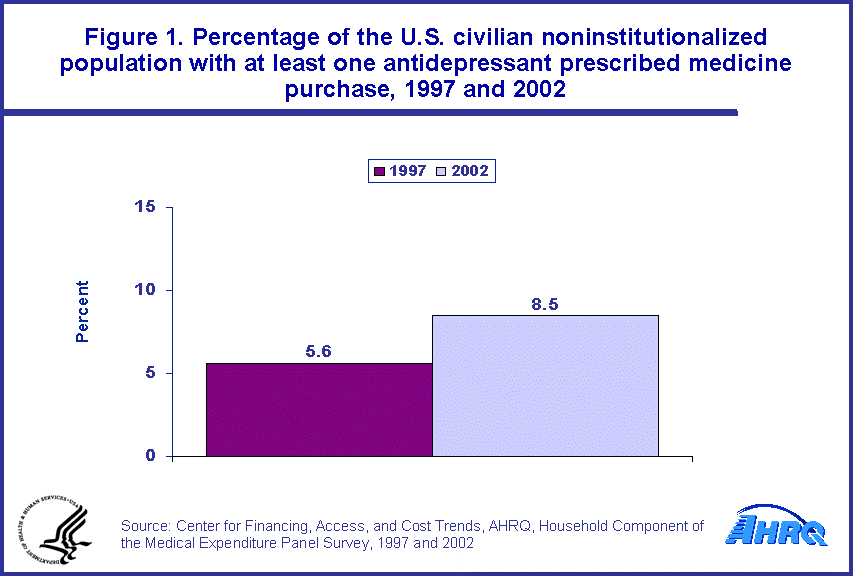 |
||||||||||||||||||||||||||||||
|
||||||||||||||||||||||||||||||
|
|
||||||||||||||||||||||||||||||
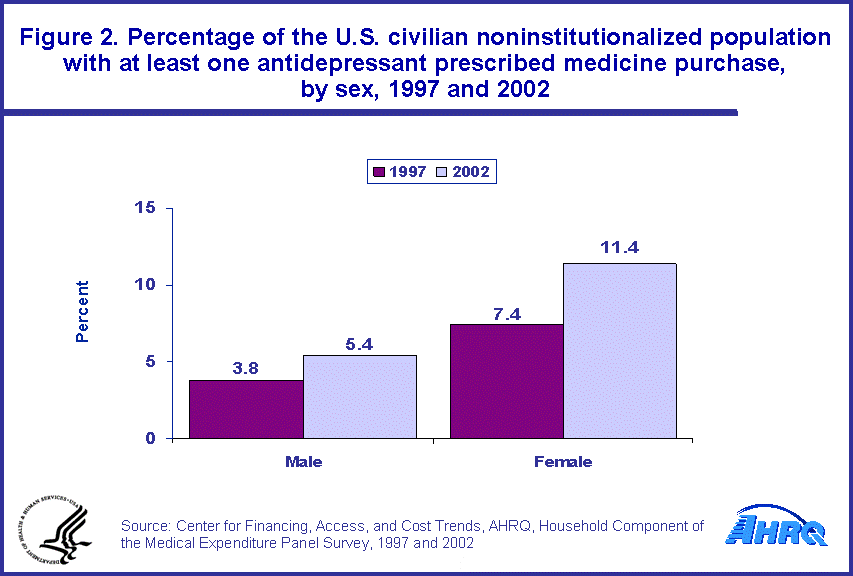 |
||||||||||||||||||||||||||||||
|
||||||||||||||||||||||||||||||
|
|
||||||||||||||||||||||||||||||
 |
||||||||||||||||||||||||||||||
|
||||||||||||||||||||||||||||||
|
|
||||||||||||||||||||||||||||||
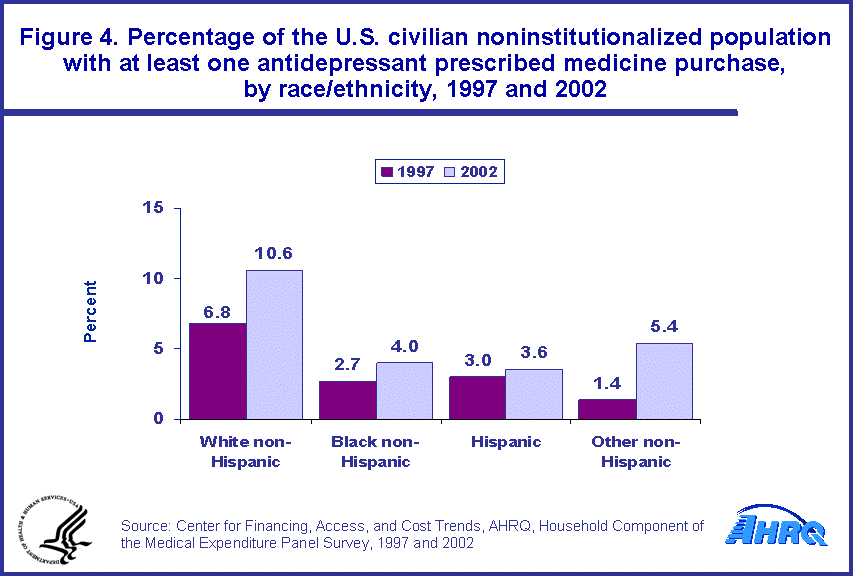 |
||||||||||||||||||||||||||||||
|
||||||||||||||||||||||||||||||
|
|
||||||||||||||||||||||||||||||
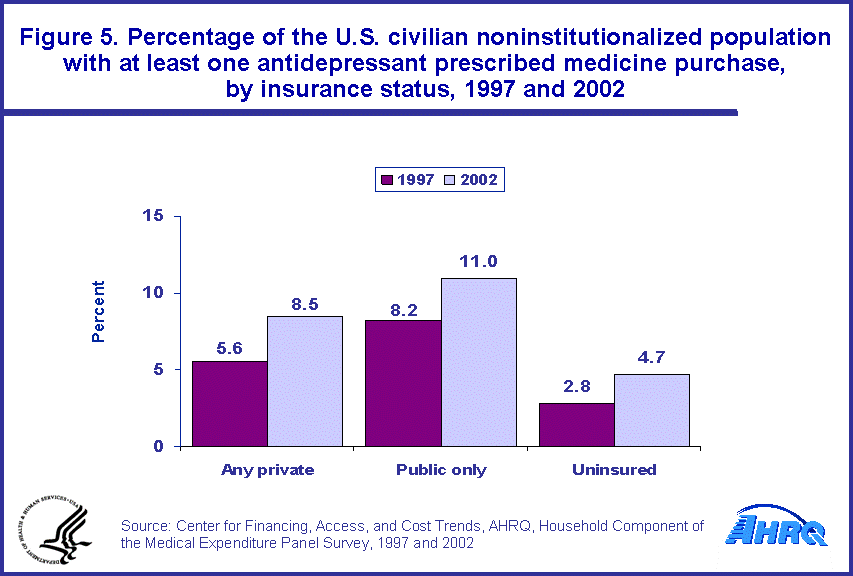 |
||||||||||||||||||||||||||||||
|
||||||||||||||||||||||||||||||
|
|
||||||||||||||||||||||||||||||
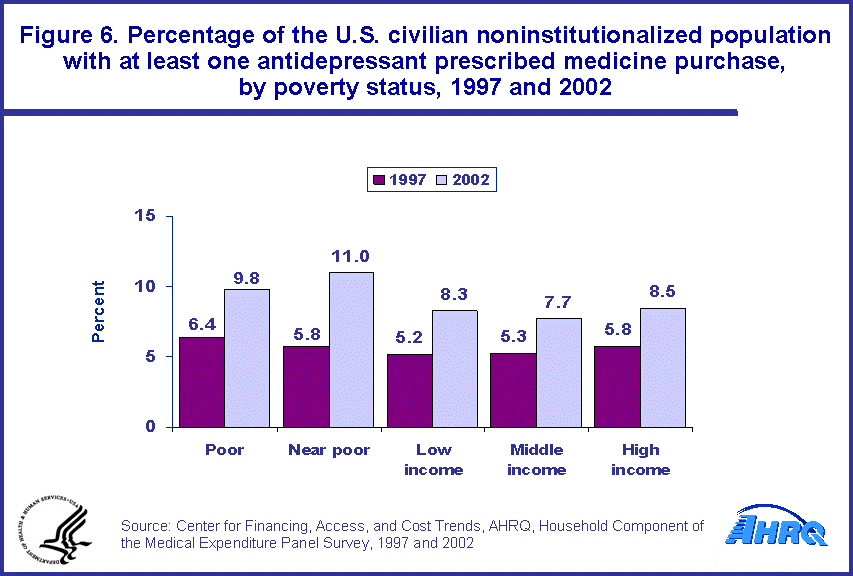 |
||||||||||||||||||||||||||||||
|
||||||||||||||||||||||||||||||
|
|
||||||||||||||||||||||||||||||


